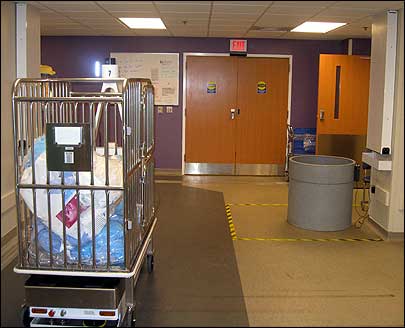Quite a few hospitals are using active RFID to help locate and manage portable X-ray machines and other equipment. The Greenville Hospital System University Medical Center is no different. But the South Carolina health-care organization, which spans five hospital facilities, has added an extra component: Its RFID solution also leverages passive EPC Gen 2 RFID tags that identify expensive surgical probes before they end up in the trash. The tags will soon be used to keep tabs on approximately 5,000 medical devices, such as infusion pumps.
The RFID deployment, implemented in the surgical department of the organization’s 750-bed tertiary Greenville Memorial Hospital, includes a mix of Wi-Fi-enabled active tags and EPC Gen 2 passive tags, a Cisco Wi-Fi network (currently installed in the surgical department, and being expanded throughout the entire hospital), ThingMagic‘s EPC Gen 2-based Mercury5 and Astra RFID interrogators, and an RFID portal from Industrial Portals, a division of Jamison Door.

This flexibility enables the hospital to leverage various types of tags, including small passive RFID tags that can fit on surgical probes, each worth thousands of dollars. The probes are so small they are sometimes lost in soiled linens and disposable items removed following surgical procedures. “We decided to implement active RFID to track high-cost medical devices within our 30 OR suites, using a Wi-Fi network,” says John Mateka, Greenville Hospital System’s executive director of materials services. “But there are smaller devices that we also wanted to track. We are not so concerned about the location of these devices, but we want to identify if any of them inadvertently get thrown in the trash.”
Integrated Business Systems and Services (IBSS), a Columbia, S.C., systems integrator and RFID solutions provider, worked with the hospital to set up an RFID portal in its hallway, through which all used disposable materials and soiled linens leave the surgical department and are moved, on carts, either to biomedical and standard trash bins, or to holding area for soiledlinens.
Now, if a cart containing a tagged surgical probe is pushed through the portal, the portal’s built-in Mercury5 interrogator detects the tag and sounds an alarm, and an employee pushes the cart to the side, rather than continuing to take it away. At the same time, the portal captures the tag read and communicates that information, via the Wi-Fi network, to IBSS’ SynTrack for Healthcare application, which automatically issues e-mail alerts to the appropriate personnel, thereby letting them know a cart may contain a probe.
The RFID portal—which, like the rest of the RFID solutions, was installed approximately six months ago—has already earned its keep. Less than two weeks ago, the portal caught its first item misplaced in the trash: a $17,000 probe buried in a cart filled with soiled items. “Understand that in the OR setting, we use a lot of drapes and plastic covers for the tables, and so there are a lot of disposable products within the OR,” Mateka says. “In fact, the majority of products, other than instruments, are disposable. This was the first time [the alarm sounded] since we put in the system, and we like to think that we have good procedures and we aren’t throwing too much away.”
To be safe, the hospital wants to tag additional instruments. Although metal detectors can catch many such devices, the RFID portal serves as a backup. But the tags, which can not tolerate steam sterilization, can be used only on probes and instruments cleaned with a sanitizing solution that the tags can withstand. “We’re limited right now,” Mateka says, “although we understand there are tags that are being developed to withstand steam sterilizing, and we’ll look into that.”
In addition, the hospital is leveraging the passive tags to track a variety of medical devices that get moved around, such as infusion pumps. The hospital opted not to utilize the more expensive Wi-Fi active tags, which can track locations in real time. By positioning passive interrogators in storage areas, on particular floors, or in specific sections, the staff will be able to map a device’s last documented position. “The system will tell you where it was last seen,” Mateka states. “Sometimes that’s sufficient, because you don’t need to know exactly where it is at. Often, you just need to know if it is in an area, or not in an area.”
Moreover, the hospital plans to take advantage of the tracking data and reporting tools provided by the SynTrack for Healthcare application. “The system can stop a probe from going in the trash, and we are really excited about that,” Mateka says. “But we can also backtrack and figure out how it happened. Who were the people involved? What were the processes involved? We can research how it happened so we can prevent it from happening again. This moves from asset tracking to productivity, quality and efficiency measurement, because it adds visibility to invisible processes.”
According to Mateka, the hospital also plans to expand its use of RFID. “We are still in the process of upgrading our Wi-Fi network throughout the hospital,” he says, “and we are now looking at the critical care areas and the ER. We will just follow IT as they upgrade the infrastructure and provide us with antennas we need. We will expand in the main hospital, and then move to our other hospitals.”

